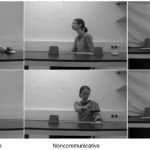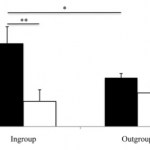
Here are my Research Blogging Editor's Selections for this week.
The first selection this week comes from Chad Orzel at Uncertain Principles. "But wait," you say. "A psychology post in a physics blog?" Yes! Active Engagement Works: "Improved Learning in a Large-Enrollment Physics Class"
Autism diagnosis in cultural context. Dorothy Bishop reviews a recent book on autism, and in doing so, reviews quite a bit about autism itself. A great read!
That's it for this week... Check back next week for more great psychology and neuroscience blogging!
Human infants have one important job during the first years of life, and that is to learn about the world and their culture from their parents and other caregivers. But what is learning? I've previously written that Hungarian developmental psychologists Gergely and Csibra have defined learning as the acquisition of new, generalizable knowledge that can later be used within a new context. Further, they have posited that evolution has prepared humans to learn generalizable knowledge from their caregivers. They proposed an elegant hypothesis: that a specialized innate pedagogy mechanism - called…
Here are my Research Blogging Editor's Selections for this week.
Are you an inattentive superhero? Bradley Voytek thinks so, and explains why in this fantastic post at Oscillatory Thoughts.
Does visual perception for the actions of others alter perception of the passage of time? Mo Costandi at Neurophilosophy describes a recent paper addressing this very question.
Can having lots of choices in life make us more selfish and less empathic towards others? At Not Exactly Rocket Science, Ed Yong writes about a series of experiments that suggest the answer is yes. Also, there's bacon.
That's it…
My latest piece for LAist just went up:
Retail therapy: It's the answer for almost any problem. Girlfriend broke up with you? Didn't get that promotion? Buy yourself something pretty. People like to shop, especially for high-status items, when they're feeling down. Decades of research has indicated that when a key feature of one's identity is threatened - such as by being passed over for a promotion or being dumped by a former lover - people turn to things. Possessions can allow us to signal our awesomeness to others. And if others think we're awesome, then we just might begin to remember…
Being a great science teacher is not so different from being a great science writer. You have to convince your audience to pay attention to you, rather than to the myriad other potential sources of entertainment and engagement out there. You have to maintain their attention: at any time, a reader can click over to a different website or turn the page of the magazine or newspaper. You have to break down complex ideas into understandable chunks.
The writer is making an unstated contract with the reader. The writer says to the reader: I will value you and your time, because I know that you are…
Here are my Research Blogging Editor's Selections for this week.
What can the spinal cord teach us about learning and memory? A lot, it seems. Bjorn Brembs has the scoop.
How do box jellyfish hunt their prey? With each of their TWENTY-FOUR eyes! Mo Costandi explains at Neurophilosophy.
That's it for this week... Check back next week for more great psychology and neuroscience blogging!
What is learning?
Most psychologists (indeed, most people in general) would agree that learning is the acquisition of new knowledge, or new behaviors, or new skills. Hungarian psychologists Gergely and Csibra offer a deceptively simple description: "Learning involves acquiring new information and using it later when necessary." What this means is that learning requires the generalization of information to new situations - new people, objects, locations, or events. The problem is that any particular piece of information that a human or animal receives is situated within a particular context…
Here are my Research Blogging Editor's Selections for this week.
To start with, is there anything that might help with exposure therapy for specific phobias? Michelle from C6-H12-O6 describes a paper that suggests that the administration of cortisol might!
While many people claim to not be able to dance, if pressed, most could dance to a beat. Nearly all of us can at least identify when others are on or off rhythm. Over at Neuropoly, DJ discusses a newly discovered form of congenital amusia: beat deafness.
If there is anything cooler than a retina grown in a dish, I'm not sure what it is.…
There's a very well-known experiment in developmental psychology called the "A-not-B task." The experiment goes something like this: you, the experimenter, are seated opposite a human infant. Within the reach of both you and the child are two boxes: box "A," and box "B." You hide a toy in "A," in full view of the infant. As expected, the infant reaches for "A" to retrieve the toy. You repeat the process several times. Each time you hide the toy in "A," and each time the infant reaches for "A" to find the toy. Experimental set-ups like this are extremely common in infant and animal studies.…
First, the first couple of reviews of the 2010 anthology are now out: by Dr. Alistair Dove at Deep Sea News and by Ariel Carpenter at USC News. Check them out. If you have read the book and have a place to publish a review, we'll appreciate it - just send us the link.
Second, I am very excited to join Bora in announcing the Guest Editor for the 2011 edition: Jennifer Ouellette (blog, Twitter). I am sure that Jennifer will do a fantastic job putting together the sixth edition of the anthology! I couldn't be more thrilled.
Third, after five years of self-publishing the anthology through Lulu.…
Here are my Research Blogging Editor's Selections for this week:
To start things off, Krystal D'Costa of Anthropology in Practice discusses the science of women's shoes.
Was the "Gay Caveman" really gay? Or even a caveman? Eric M. Johnson takes his blog tour to David Dobbs's Neuron Culture blog: The Allure of the Gay Caveman.
It is often suggested that differences in neural connectivity or wiring may underlie some psychopathologies. Here's some evidence from Neuroskeptic that this may indeed be the case, at least for schizophrenia. Maybe.
What are the ten most cited papers in Neuroscience?…
The first two reviews (that I'm aware of) of this year's edition of Open Lab have surfaced!
First, USC ran a fantastic story on Open Lab and on my experiences with science blogging more generally. It was placed prominently (to my surprise) at the front page of the USC website for a week, and included in the weekly email of the USC College of Letters, Arts, and Sciences! Thanks to Ariel Carpenter for such a great article.
Do Japanese people have a special sushi-digestion gene? What are 10 things everyone must know about comets? Can giraffes swim?
Inquiring minds from the Internet's vibrant…
A couple weeks ago, I asked readers to offer up some science blogs written by women.
I wrote:
Throughout the month of March, The Smithsonian Channel aired all-new original programming, exploring the scientific contributions of five female scientists: Elisabeth Blackburn, JoGayle Howard, Nan Hauser, Elisabeth Kalko, and Gudrun Pflueger. (I featured one of the programs, about Gudrun Pflueger, earlier this month.)
As the month of programming wraps up, in order to commemorate the Women in Science programming, and to celebrate Women in Science more generally, I've got some schwag from the…
I've been a bit remiss in posting much this week, mostly because I had to prep a guest lecture (from which I just returned, and it was awesome thankyouverymuch) on the Domestication of Social Cognition.
In the meantime, now that spring is here, baby animals are starting to pop up all over the LA Zoo. I haven't managed to make it to the zoo yet to see them, but in the meantime, enjoy these pictures (click each one to enlarge) provided by the zoo itself.
This baby koala (not a bear! koalas are marsupials, like kangaroos) was actually born on July 6, but because koalas, like kangaroos, spend the…
Here are my Research Blogging Editor's Selections for this week:
Liberals Are Conflicted and Conservatives Are Afraid and Colin Firth is published in Current Biology. From the Neurocritic.
Despite what beer commercials tell you, not everyone responds to alcohol in the same way. The Science Life blog discusses the science of drinking.
How does an octopus integrate its visual perception with its motor actions in order to navigate? Seems simple, but a great post at Cephalove suggests that it might not be as easy as it sounds. If you're an octopus, that is.
I'm working on putting together a resource sheet for various people (teachers, professors, graduate students, etc) that will help them find psychology-related resources on the web.
And I can use your help. To start with, I'm compiling as extensive a list as is reasonably possible of psychology and related blogs.
Here is a starter list, that I put together in about five minutes. What other blogs do you read, that I don't have listed here, that belong in the list? The criteria are (1) they're good, (2) they do research blogging (though they need not exclusively do research blogging, and they…
This newest addition to the Cincinnati Zoo, a female giraffe, was born last Saturday, April 2, 2011.
She's the first giraffe born at at the Cincinnati Zoo in 26 years. Head on over to their facebook page and suggest a name!
Oh, and did you know that giraffes can (sort of) swim? Check out Darren Naish's post on the topic - it was, incidentally, one of the 50 posts selected for this year's Open Lab.
You know that old phrase, "monkey see, monkey do"? Well, there might be something to it, except that chimpanzees aren't monkeys. (Sadly, "ape see, ape do" just doesn't have the same ring to it.) A new paper published today in PLoS ONE has found evidence that chimpanzees have contagious yawning - that is, they can "catch" yawns from watching other chimpanzees yawning - but (and here's the interesting part) only when the chimp that they're watching is a friend.
At first, scientists thought that contagious yawning was the result of a releasing mechanism - in other words, seeing someone yawn…
Here are my Research Blogging Editors Selections for this week:
Is there a relationship between the taste of certain foods and moral decision-making? Maybe. At The Jury Room: Make them eat brussel sprouts.
In a somewhat related post, Dr. Stu of his eponymous blog asks if your music selection can make your food taste better or worse. The answer might surprise you.
What is the relationship between conscious awareness and the experience of pain? Flavia di Pietro of Body in Mind explores the question. Nociception by any other name will hurt, or not hurt, just as much.
Finally, and for the…
Given the recent elephant hunting scandal, I thought I'd repost this award-winning piece from the archives, on a very clever way to deter elephants from raiding human settlements. Much cleverer than shooting them. (Click on the archives icon for the original.)
What information is contained in the call of a mammal? Some calls might reflect the internal emotional state of the animal, like fear or anxiety, or they can refer to an external object, agent, or event, like the presence of a predator. Rhesus monkeys, lemurs, baboons, and guinea pigs, for example, will produce calls when separated from…





